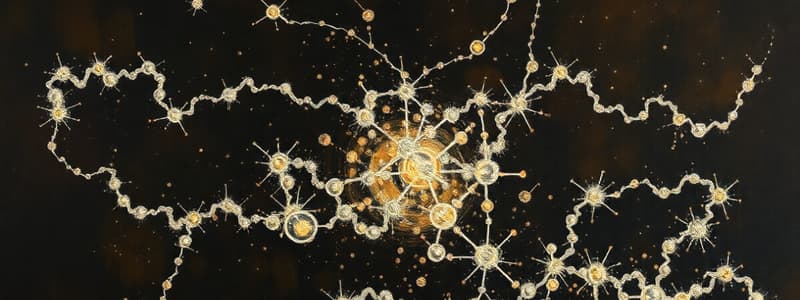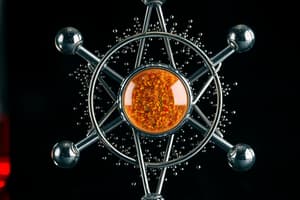Podcast
Questions and Answers
What is the key characteristic of atoms according to Dalton's atomic theory?
What is the key characteristic of atoms according to Dalton's atomic theory?
- Atoms are always visible to the naked eye.
- Atoms of one element are all identical. (correct)
- Atoms can be divided into smaller particles.
- Atoms can change into different elements.
What type of bond typically occurs between a metal and a non-metal?
What type of bond typically occurs between a metal and a non-metal?
- Hydrogen Bond
- Covalent Bond
- Polar Covalent Bond
- Ionic Bond (correct)
What is the range of electronegativity difference that indicates a polar covalent bond?
What is the range of electronegativity difference that indicates a polar covalent bond?
- 0.5 to 1.6 (correct)
- 0.0 to 0.4
- ≥ 2.6
- 1.7 to 2.5
According to Dalton, what forms when atoms combine?
According to Dalton, what forms when atoms combine?
In terms of polarity, what signifies the distribution of electric charge among atoms in a bond?
In terms of polarity, what signifies the distribution of electric charge among atoms in a bond?
What molecular shape is characterized by a central atom with two bonded atoms and two lone pairs?
What molecular shape is characterized by a central atom with two bonded atoms and two lone pairs?
Which of the following compounds exhibits a tetrahedral molecular shape?
Which of the following compounds exhibits a tetrahedral molecular shape?
What type of bond is formed when electrons are shared unequally between atoms?
What type of bond is formed when electrons are shared unequally between atoms?
Which molecular shape features three bonded atoms arranged in a triangle around a central atom?
Which molecular shape features three bonded atoms arranged in a triangle around a central atom?
Identify the molecular shape that consists of four bonded atoms arranged in a flat square.
Identify the molecular shape that consists of four bonded atoms arranged in a flat square.
What is the bond angle in a tetrahedral molecular structure?
What is the bond angle in a tetrahedral molecular structure?
Which molecule is an example of a pyramidal molecular shape?
Which molecule is an example of a pyramidal molecular shape?
Which of the following best describes electronegativity?
Which of the following best describes electronegativity?
What effect do lone pairs have on bond angles in molecular structures?
What effect do lone pairs have on bond angles in molecular structures?
Which of the following molecules is an example of a polar molecule?
Which of the following molecules is an example of a polar molecule?
What is the definition of solubility?
What is the definition of solubility?
What does the phrase 'like dissolves like' imply?
What does the phrase 'like dissolves like' imply?
What characterizes polar bonds in a molecule?
What characterizes polar bonds in a molecule?
Which of the following statements is true regarding miscibility?
Which of the following statements is true regarding miscibility?
Which molecular structure is primarily characterized by having tetrahedral bond angles?
Which molecular structure is primarily characterized by having tetrahedral bond angles?
What type of charge separation indicates a molecule is polar?
What type of charge separation indicates a molecule is polar?
Which pairs of substances are likely to mix due to their polarity?
Which pairs of substances are likely to mix due to their polarity?
Which of the following statements about intermolecular forces of attraction (IMFA) is true?
Which of the following statements about intermolecular forces of attraction (IMFA) is true?
Which of the following correctly pairs a physical property with its definition?
Which of the following correctly pairs a physical property with its definition?
Which substances are nonpolar and would likely not mix with polar substances?
Which substances are nonpolar and would likely not mix with polar substances?
Which property generally decreases as the strength of intermolecular forces increases?
Which property generally decreases as the strength of intermolecular forces increases?
What happens to viscosity when intermolecular forces are weakened?
What happens to viscosity when intermolecular forces are weakened?
Which of the following mixtures would be expected to have the highest boiling point?
Which of the following mixtures would be expected to have the highest boiling point?
What defines the vapor pressure of a substance?
What defines the vapor pressure of a substance?
Flashcards
Atomic Theory
Atomic Theory
Dalton's theory proposes that atoms are tiny, indivisible particles that differ in elements.
Ionic Bond
Ionic Bond
A bond formed when a metal loses electrons and a nonmetal accepts those electrons.
Covalent Bond
Covalent Bond
A bond formed when atoms share electron pairs.
Electronegativity
Electronegativity
Signup and view all the flashcards
Polarity of a molecule
Polarity of a molecule
Signup and view all the flashcards
Polar Covalent Bond
Polar Covalent Bond
Signup and view all the flashcards
Bent Molecular Shape
Bent Molecular Shape
Signup and view all the flashcards
Tetrahedral Shape
Tetrahedral Shape
Signup and view all the flashcards
Trigonal Molecular Shape
Trigonal Molecular Shape
Signup and view all the flashcards
Pyramidal Molecular Shape
Pyramidal Molecular Shape
Signup and view all the flashcards
Square Planar Shape
Square Planar Shape
Signup and view all the flashcards
VSEPR Theory
VSEPR Theory
Signup and view all the flashcards
Lone Pair Repulsion
Lone Pair Repulsion
Signup and view all the flashcards
Xenon Tetrafluoride (XeF4)
Xenon Tetrafluoride (XeF4)
Signup and view all the flashcards
Polar Molecule
Polar Molecule
Signup and view all the flashcards
Non-Polar Molecule
Non-Polar Molecule
Signup and view all the flashcards
Solubility
Solubility
Signup and view all the flashcards
Miscibility
Miscibility
Signup and view all the flashcards
Like Dissolves Like
Like Dissolves Like
Signup and view all the flashcards
Polarity and Solubility
Polarity and Solubility
Signup and view all the flashcards
Polar & Non-Polar Mixtures
Polar & Non-Polar Mixtures
Signup and view all the flashcards
Intermolecular Forces (IMFA)
Intermolecular Forces (IMFA)
Signup and view all the flashcards
Stronger IMFA = ?
Stronger IMFA = ?
Signup and view all the flashcards
Vapor Pressure
Vapor Pressure
Signup and view all the flashcards
Boiling Point
Boiling Point
Signup and view all the flashcards
Study Notes
John Dalton's Atomic Theory
- Dalton (1808) created the first atomic theory
- He conducted experiments on atoms
- Dalton viewed atoms as tiny, solid spheres
Dalton's Atomic Theory Statements
- Atoms are tiny and indivisible particles
- Atoms of the same element are identical
- Atoms of different elements are different
- Compounds are formed by combining atoms
Types of Chemical Bonds
- Ionic Bonds: Occur between metals and nonmetals
- Metal loses electrons, nonmetal gains electrons
- Covalent Bonds: Occur between nonmetals
- Electrons are shared between atoms
Bond Polarity
- Electronegativity difference determines bond polarity
- High difference (≥ 1.7): Ionic bond
- Moderate difference (0.5 to 1.6): Polar covalent bond
- Low difference (< 0.4): Nonpolar covalent bond
Molecular Shapes
- Linear: Atoms arranged in a straight line (180°)
- Bent: Atoms arranged in a "V" shape (< 120° for example)
- Trigonal planar: Atoms arranged in a flat triangle (120°)
- Tetrahedral: Atoms arranged in a three-dimensional pyramid shape (approximately 109.5°)
- Square planar: Atoms in a flat square around the central atom (90°)
Molecular Polarity
- Polar molecules have opposite charges on different parts of the molecule.
- Nonpolar molecules have even charge distribution
Examples of Molecular Shapes
- Linear: CO2, BeCl2
- Bent: H2O, NO2
- Trigonal planar: BF3, NO3
- Tetrahedral: CH4, NH4+
- Square planar: XeF4
Examples of substances
- Carbon dioxide (CO2)
- Beryllium chloride (BeCl2)
- Nitric oxide (NO)
- Beryllium fluoride (BeF2)
- Hydrogen cyanide (HCN)
- Xenon difluoride (XeF2)
- Methane (CH4)
- Silane (SiH4)
Studying That Suits You
Use AI to generate personalized quizzes and flashcards to suit your learning preferences.
Related Documents
Description
This quiz covers John Dalton's atomic theory, including its core statements and principles. Additionally, it explores different types of chemical bonds, their properties, and the concept of bond polarity. Test your understanding of atomic theory and molecular shapes!



